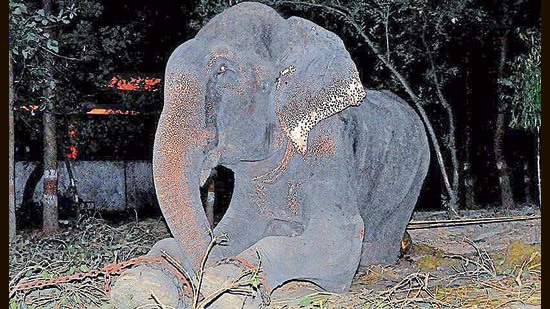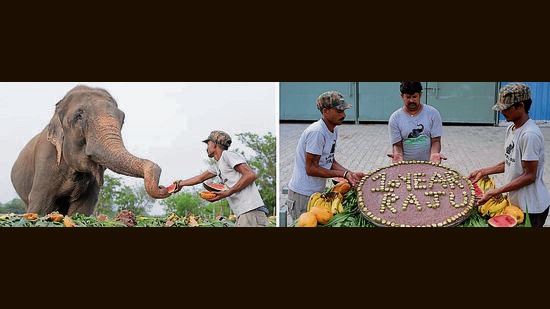A decade of Raju’s happiness
Upon rescue, Raju turned into a symbol of hope for elephant conservation in India. “Awareness about Raju’s exploitation created a turning point for the way elephants were cared for
Raju, the “crying elephant”, celebrated a decade of freedom from chains, beatings and ‘tears’. He was rescued as a veritable skeleton from the street begging trade on July 4, 2014, having suffered severe wounds and emotional traumas. Raju’s rescue drew national and international attention to the plight of the gentle giants.

Raju has turned 60. He currently spends most of his time splashing in his exclusive pool, dozing off in the water and gobbling his favourite melons at the Wildlife SOS Elephant Hospital, Mathura. He came to Wildlife SOS after changing 20 exploitative owners during his first 50 years. Each ownership change entailed severe beatings, food deprivation and torture so that the new ‘mahout’ could break Raju’s spirit and submit the elephant to his will.
Upon rescue, Raju turned into a symbol of hope for elephant conservation in India. “Awareness about Raju’s exploitation created a turning point for the way elephants were cared for. When Raju arrived at the hospital in 2014, there were nearly 70 elephants estimated to be still active in circuses across India. Today, all performing animals are banned from circuses, including elephants. At the time of Raju’s rescue, elephants were seen roaming the streets of Delhi, being hired for wedding ceremonies and processions. Five years later, by 2019, all elephants had been removed from the capital with the last one, Jasmine, coming to live at Wildlife SOS. Raju’s rescue helped expose the grim reality of tourist rides and the associated elephant abuse. With it, the hospital was able to strengthen the message of its campaign ‘Refuse To Ride’,” stated a Wildlife SOS media release.
Raju’s rescue created an emotional connect as the elephant had “wept” that night in 2014 when his chains were cut. Elephants naturally secrete from their eyes to ward off dryness and sand storms. But that night, rescuers noticed that Raju’s eyes profusely released secretions in dark streams down his face. Ever since, Raju came to be known as the crying elephant.

A Goanese girl, Rhea Lopez, was so moved that she came to Mathura in 2015 and volunteered to work with the elephants and meet Raju. “Raju has not disappointed, he is as wonderful as I had imagined him to be,” Lopez had told Wildlife SOS.
Geeta Seshamani, secretary, Wildlife SOS, gives us an idea of how Raju touched so many lives across countries. “I think it was the first time the suffering of a captive elephant was so visibly exposed to the world, and Raju, being such an emotional elephant, made an immediate connection with everyone. To see such a magnificent creature bowed down by chains, hobbled with spiked anklets, and bearing countless ankush wounds was truly heartbreaking,” said Seshamani.
There is another facet to Raju’s character. He is almost Buddha-like in his serenity after having suffered enormously, though, he does get quite excited when the mating season arrives and he picks up the ‘scent of a woman’ from the adjoining compound of female elephants!
“Raju may seem a towering animal but he has the most calm disposition. He beckons us with characteristic calls and body language expressions when he is hungry or when he wants the pool water changed. Elephants are intelligent, possess a good memory and are emotional. Raju seems to be talking to us and expressing gratitude for treating him well,” his caregiver of several years, Asif, told this writer.
If Raju could write a memoir on his years chained and under the jackboot of remorseless mahouts, the script would parallel the horrific recounts of Auschwitz inmates.






